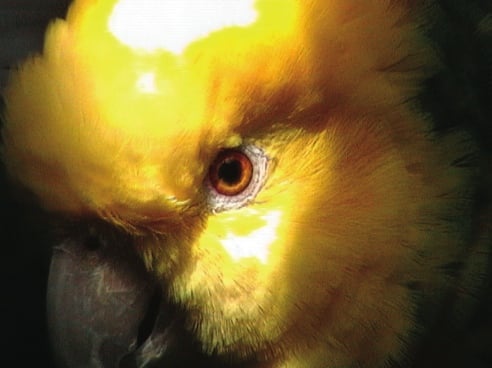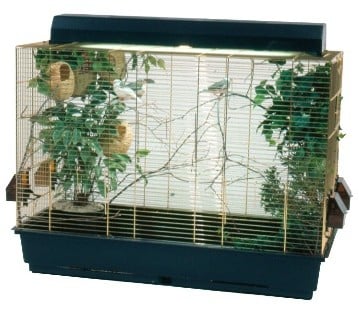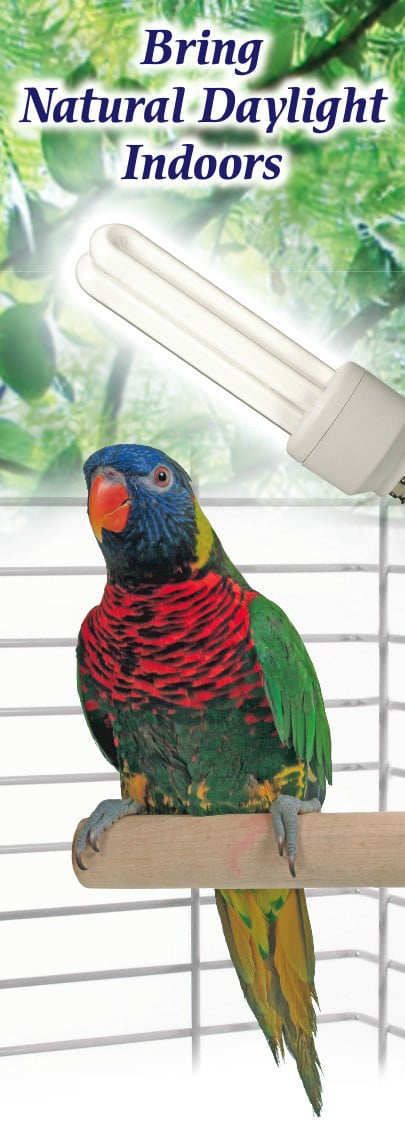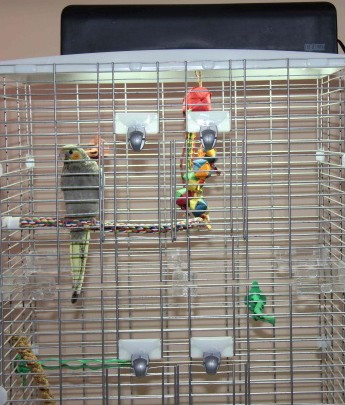Your cart is currently empty!

HARI Official Brand Site

Consult your avian health care specialist for correct use of Vitamin D supplements, especially when used in conjunction with pelleted diets, special lighting, or with outdoor housing.
Bird breeders and fanciers around the world have long believed in the benefits of natural sunlight and fresh air for our avian companions. In countries such as Australia, captive birds are almost always housed outdoors. Here in North America, many of us are not blessed with a climate that permits this. Still, given a little knowledge and ingenuity, we can achieve not only the visual appeal but many of the healthful advantages that come with natural or special lighting. Remember that we humans are always grumbling about office light or long dark winters -imagine, then, the justified complaints of creatures whose natural habitat isn’t a lobby, a mall, or a living room!
Let’s first take a look at the physiological impact of natural light on your bird. As a veterinarian, one of my chief concerns about light quality is in regard to Vitamin D metabolism.
Vitamin D is the only vitamin that normally requires a specific type of light (ultraviolet light, which comes from the sun) to convert it into its active form. When birds in the wild ingest Vitamin D in their food, the sun’s ultraviolet fraction converts it into a fundamental component of good health – the chemically active form Vitamin D3 (25-dihydroxycholecalciferol). Without this exposure to sunlight, Vitamin D deficiency problems such as rickets can develop in birds.

In theory, modern medicine has made it possible to compensate for a lack of direct sunlight by feeding the bird an artificially produced chemically active form – much like our own vitamin supplements – but this approach is not without problems. One of the key issues is correct dosage. Unfortunately, owners who are careless with prescribed doses may be endangering their pet’s well-being, as Vitamin D3 may be toxic when given in excess. Frustratingly, we do not know the minimum and maximum safe level of supplements for most pet species. We do know that certain parrots such as the macaws seem to be particularly sensitive to Vitamin D3 overdose. In fact, when breeding macaws are housed outdoors, and given high levels of Vitamin D3 supplement in their food – at a level that might be safe for indoor housed macaws – it may be possible in those circumstances for an overdose to occur. Typical problems include renal failure, widespread tissue calcification, and breeding difficulties.

The issue of Vitamin D supplements, then, demands a little thought. But in most cases you will not be able to omit supplements altogether, because without access to activated Vitamin D the ‘indoors’ bird cannot absorb calcium normally from its food, and the results are catastrophic. Young birds in particular may develop bent and malformed beaks, and bowed and softened leg bones, together with malformations of the ribs and spinal column. The best course of action is to use adequate, not excess, Vitamin D3 supplementation, and to provide access to natural unfiltered sunlight or full spectrum light wherever possible. We do know that full spectrum fluorescent lighting does result in adequate vitamin D activation in chickens, and almost certainly in other bird species
Consult your avian health care specialist for correct use of Vitamin D supplements, especially when used in conjunction with pelleted diets, special lighting, or with outdoor housing.

We’ve all seen pictures of the serious breeder and enthusiast, whose aviaries are often festooned with special lights and lamps. Many of these owners are using UVB or ‘full spectrum light’, which may have several benefits when used with companion birds. Full spectrum light consists of fluorescent tubes which imitate natural sunlight by producing a broad range of optical radiation. In this spectrum is the all-important ultraviolet radiation, vital to the processing of Vitamin D, and invisible to the human eye. It is the middle range ultraviolet called ‘UVB’ which activates vitamin D. Full spectrum lights also approximate the color ‘palette’ of outdoor light. By definition, full spectrum or broad spectrum (similar meaning) lights have a high color rendering index (CRI > 88), meaning that the color balance is similar to that of natural noon-time sunlight, and they have a color ‘temperature’ between 5000 and 6600 K. Higher color temperatures are more ‘sun-like’ than cool white office fluorescents. How is this done? Fluorescent lights are made up of glass tubes containing inert gases such as argon, and coated with chemical ‘phosphors’ which emit light at various wavelengths when an electrical current causes electrons to strike them. These phosphors give the fluorescent light its special properties. Although most full spectrum lights are targeted for the reptile market, the trend in the industry is now focusing on specifically manufactured lights for birds.
However, correct use of full spectrum lighting involves a little homework. There is no information available on exactly how much ultraviolet light is needed (or is safe) for indoor birds.
Remember also that percentages of UVB listed on tube packaging are not usually much help unless you know the total output of the bulb. Your pet retailer should be able to put you in touch with a manufacturer’s web site or customer service department if you have questions about the value of a particular bulb for avian species. Fluorescent lights are easy to set up and to use, but follow the manufacturer’s guidelines for replacement times. Most emit useful amounts of UVB for at least one year. These lights should be replaced before we are able to see them flicker. Birds can actually see this “flickering” effect in an old tube long before we can!
Let’s not forget one of the very obvious benefits of UVB lighting for companion birds – like us, our birds enjoy a bit of sunbathing! Many of our captive bird species originate from very hot climates. Most popular Australian species, for example, are from semi-arid habitats that routinely exceed 100° F in the daytime. Conditions in captivity in North America are often very different. Infra-red light can very effectively make up for lost temperature. New small ‘spotlight’ infra-red bulbs are now available that can be left on 24 hrs. a day, and their pleasant red glow will not disturb the birds at night. Infra-red is a type of incandescent light radiation, much like a “regular” light bulb. Incandescent bulbs give off light and varying amounts of heat when an electrical current is passed through a metal filament in the vacuum environment of the glass bulb. Many pet stores also use these lights for their newly arrived birds, or recently weaned birds who have been moved out of temperature controlled enclosures. Birds under stress always benefit from supplemental heat. But caution should be taken to ensure that the bird has some escape from the higher heat areas of the cage. In general, 75 watt infra-red lights are best for most bird applications when used in a reflector on the cage top. And do remember: keep all cords and fixtures away from busy beaks!
No wonder pet-store fish look so alluring and so otherworldly – proprietors use special lighting to highlight the natural beauties of their stock. Most fluorescent light sources give dazzling effects to birds as well as to fish. The jewel-like appearance of a Lady Gouldian finch or a Splendid parakeet under full spectrum light speaks for itself. Almost any light source can highlight your pet’s appeal to some extent. Start with a fresh look at your windows. Too often, worried pet owners consider windows ‘drafty’ or somehow inappropriate, and end up consigning our beautiful friends to a dim, corner location. Modern windows are rarely drafty, and intelligent pet birds often enjoy seeing activity going on outside of their window. Always make sure the bird has part of the cage in shade for refuge from direct sunlight, but otherwise take sensible advantage of window light.

Full spectrum light is ideal for visual effects as well as health benefits. You can arrange full spectrum lighting for your cage exactly as you might for a fish tank. An overhead strip light can either be mounted on the cage or ceiling, and should be placed on a timer for convenience. Make sure your strip fixture does not require a ‘manual’ start each time, or you will not be able to use a timer. Again, make sure that restless parrot-type beaks cannot reach any electrical cords. Viewing your birds will also be enhanced by dark-colored or low reflection bars, particularly when a frontal lighting source is used. Most commercial display aviaries and zoological gardens paint wire or bars black for this reason. Make sure that a zinc and lead-free, non-toxic paint or other finish is used.
Finally, a note on possibly the most important reason for you to re-assess the ways you illuminate your bird and its environment. Small changes in your birds appearance or behavior, cage damage, a dirty cage, and many other problems are easily missed in a dimly lit environment. Some changes are very subtle; an oddly colored dropping, a leg that does not grip the perch well, or an out-of- position wing are all conditions that need a little ‘enlightenment’ to pick up!
By: Louise Bauck, DVM, MVSc
Read more about the technical aspect of avian lighting recom

The classic and highly sought-after out-of-print volumes of Parrot Life Magazine